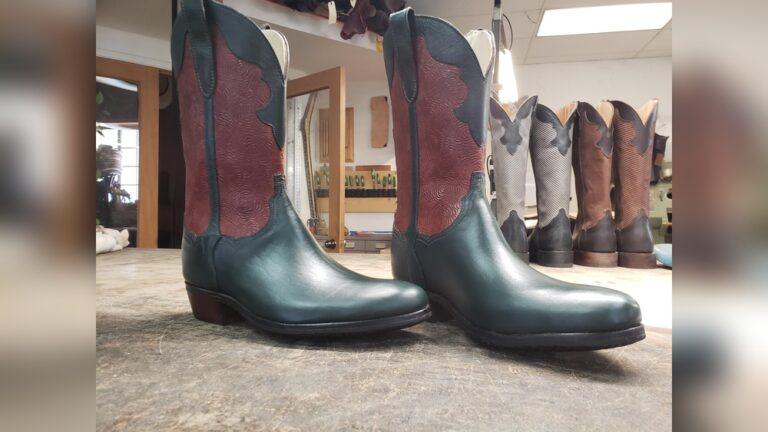Are your leather boots feeling too soft or floppy? If you want them to hold their shape better and last longer, stiffening your leather boots is the key.
Whether you’re aiming for a rugged look, extra support, or simply want your boots to stand firm, there are simple techniques you can try at home. In this guide, you’ll discover easy, effective methods to stiffen your leather boots without damaging them.
Ready to transform your boots and give them that perfect, sturdy feel? Keep reading to learn how to do it right.
Leather Types For Stiffening
Choosing the right leather type is crucial for effective stiffening. Some leathers respond well to stiffening techniques, while others may get damaged. Knowing which leather to work with ensures the best results and protects your boots.
Vegetable-tanned Leather
Vegetable-tanned leather is the best choice for stiffening. It is treated with natural tannins from plants, which makes it firm and durable. This leather absorbs water and wax well, allowing it to harden without cracking. It also develops a nice patina over time, adding character to your boots.
Full-grain Leather
Full-grain leather is another excellent option for stiffening. It retains the natural grain of the hide, making it strong and thick. This leather responds well to heat and moisture methods like soaking or baking. It stays breathable and lasts longer, making it perfect for stiff boots.
Avoiding Chrome-tanned And Delicate Leathers
Chrome-tanned leather is softer and more flexible but does not stiffen well. It can lose color or get damaged during stiffening. Delicate leathers like suede, nubuck, or patent leather should be avoided. Their texture and finish can be ruined by water, heat, or wax treatments. Protect your boots by choosing the right leather type before stiffening.

Credit: www.reddit.com
Water Soaking And Drying
Water soaking and drying is a simple, effective way to stiffen leather boots. This method softens the leather fibers, allowing you to reshape and harden the boots as they dry. The process requires attention to temperature and drying technique to avoid damage. Proper soaking and drying can give your boots a firm, lasting structure.
Soaking In Boiling Water
Use boiling water carefully to soak your leather boots. Boil enough water to cover the boots fully. Remove the pot from heat before submerging the boots. Let the leather soak for a few minutes. This softens the leather fibers and prepares them to stiffen. Avoid soaking too long to prevent shrinking or damage.
Air-drying Techniques
After soaking, air-dry the boots slowly at room temperature. Place them in a well-ventilated area away from direct sunlight or heat sources. Sunlight and heat can dry out the leather too quickly and cause cracking. Turn the boots occasionally to dry evenly. Patience is key for strong, stiff leather.
Shaping While Damp
Shape your boots while they are still damp but not dripping wet. Use shoe trees, forms, or stuff them with paper to hold the desired shape. This sets the leather fibers in place as they dry. The leather will stiffen and keep the new shape. Avoid bending or folding, which can cause unwanted creases.
Heat-based Methods
Heat-based methods offer effective ways to stiffen leather boots. These methods use controlled heat to change the leather’s structure. Heat causes the leather fibers to contract and harden. It is important to apply heat carefully to avoid damage. Below are three common heat-based techniques to firm up your boots.
Baking Leather For Firmness
Baking leather boots in an oven can increase their stiffness. Set the oven to a low temperature, around 150°F (65°C). Place the boots on a baking tray and heat them for 10 to 15 minutes. Watch them closely to prevent overheating or burning. After baking, let the boots cool naturally. This method helps the leather dry tightly and become firm.
Using A Heat Gun
A heat gun offers precise control over the stiffening process. Keep the heat gun moving to avoid overheating one area. Hold it a few inches away from the leather surface. Apply heat evenly until the leather feels stiffer. Allow the boots to cool fully before wearing. This method works well for small areas that need extra firmness.
Sunlight Exposure
Sunlight is a gentle way to stiffen leather boots. Place the boots in direct sunlight for several hours. The sun’s UV rays dry the leather and make it firmer over time. Avoid leaving the boots out too long to prevent cracking or fading. This method takes longer but is safe and natural for leather care.

Credit: www.reddit.com
Mechanical Techniques
Mechanical techniques offer practical ways to stiffen leather boots. These methods work by physically altering the leather’s fibers. They help create a firmer, more durable texture. Mechanical methods are useful for those who want a natural feel without chemicals.
Hammering and pressing are two common mechanical techniques. They give you control over the stiffness level. These methods also add unique texture and shape to the boots. Here are the key mechanical techniques you can try at home.
Hammering For Texture And Stiffness
Hammering compacts leather fibers, making the material tougher. Use a smooth hammer or mallet for this process. Gently tap the leather surface in even strokes. This action tightens the leather weave and increases stiffness.
Hammering also creates a textured look on the boots. This adds character and style while improving strength. Do not hit too hard to avoid damaging the leather. Start softly and increase pressure as needed for best results.
Pressing And Molding
Pressing shapes leather into a firm form. Use a heavy object or clamp to apply pressure. Mold the leather around a boot form or last. This helps the boots keep their shape and stay stiff.
Heat can enhance pressing effects by softening leather fibers first. Warm the leather slightly, then press it firmly. Let it cool while still under pressure. This locks the stiffness into the leather’s new shape for lasting results.
Wax Treatments
Wax treatments provide a reliable way to stiffen leather boots. They add firmness and protect the leather from moisture. Wax creates a layer that hardens as it cools and sets. This method works well for vegetable-tanned and full-grain leathers. It also enhances the boots’ durability and appearance.
Choosing The Right Wax
Select natural waxes like beeswax or paraffin for best results. Beeswax is popular for its conditioning and stiffening properties. Paraffin wax offers a harder finish but can be less flexible. Avoid synthetic waxes that may damage leather. Consider the wax’s melting point and how it will affect your boots.
Melting And Submerging Process
Heat the wax gently until it fully melts. Use a double boiler to control temperature and avoid burning. Dip the leather boots slowly into the melted wax. Ensure the entire surface is covered evenly. Remove the boots carefully and let excess wax drip off. This step allows the leather to absorb the wax deeply.
Setting Wax With Heat
After waxing, use low heat to set the wax firmly. Place the boots in a warm oven or use a heat gun at a safe distance. The heat helps the wax soak into the leather fibers. Shape the boots while the wax is warm for better form. Let the boots cool naturally to harden the wax layer.
Liquid Starch Application
Liquid starch application offers a simple way to stiffen leather boots. This method uses a common household product to add firmness without damaging the leather. It is ideal for moderate stiffness and maintains the leather’s natural look. The process involves soaking the boots in a starch solution, then drying them carefully.
Preparing The Starch Solution
Start with liquid starch from the store or make your own by mixing water and cornstarch. Use one part cornstarch to five parts water. Heat the mixture until it thickens, then cool it completely. Make sure the solution is smooth and free of lumps before use. This ensures even coverage and better stiffening.
Applying And Drying
Dip a clean cloth or sponge into the starch solution. Apply it evenly over the leather surface of the boots. Avoid soaking the leather too much to prevent damage. After application, let the boots air dry in a well-ventilated area. Avoid direct sunlight to reduce color changes and cracking.
Achieving Desired Hardness
Check the stiffness once the boots are dry. Repeat the starch application if more hardness is needed. Each coat will add more firmness but do not overdo it to keep the leather flexible. Patience is key to reaching the perfect balance of stiffness and comfort.
Potential Effects On Leather
Stiffening leather boots changes the leather’s natural properties. These changes can affect the boot’s look and feel. Knowing these effects helps you choose the best stiffening method. It also protects your boots from damage. Below are the main effects to watch for during stiffening.
Color Changes
Leather color can change after stiffening. Water and heat often darken vegetable-tanned leather. The color may become uneven or blotchy. Wax treatments can add a slight shine or tint. Chrome-tanned leather might fade or lose color. Always test on a small area before full treatment.
Shrinkage Risks
Leather shrinks when exposed to hot water or heat. Boiling water can cause significant shrinkage. This may alter the boot’s size and shape. Shrinkage can make boots tighter and less comfortable. Slow drying avoids sudden shrinking. Control heat carefully for best results.
Texture Alterations
Stiffening changes leather texture. Hammering compacts fibers, making leather harder. Wax adds a protective layer and slight stiffness. Liquid starch leaves a firm but flexible feel. Overdoing treatments can make leather brittle. Keep texture changes mild to maintain comfort.
Tips For Durable Support
Providing durable support to leather boots is essential for comfort and longevity. Proper stiffening ensures your boots keep their shape and protect your feet well. Below are key tips to help you achieve strong, lasting support.
Combining Methods
Use more than one stiffening method for better results. For example, soak the leather first to soften it. Then apply wax or a liquid starch solution to add firmness. After that, use gentle hammering to compact the fibers. Combining methods strengthens the leather and improves durability.
Maintenance After Stiffening
Keep your boots in good shape after stiffening by cleaning them regularly. Use a soft brush or cloth to remove dirt. Apply leather conditioner to prevent drying and cracking. Avoid soaking your boots in water again unless necessary. Store them in a cool, dry place to maintain stiffness.
Avoiding Common Mistakes
Do not over-soak leather, as it can weaken fibers. Avoid using high heat during baking to prevent damage. Skip harsh chemicals that may discolor or dry out the leather. Do not stiffen delicate leathers like suede or nubuck. Follow instructions carefully to protect your boots’ quality.

Credit: www.youtube.com
Frequently Asked Questions
Can You Make Leather Stiffer?
Yes, you can stiffen leather by soaking, air-drying, baking, hammering, waxing, or using liquid starch. Vegetable-tanned leather stiffens best.
How To Stiffen Up Leather Shoes?
Soak leather shoes in water, shape them, then air-dry or bake at low heat. Wax or liquid starch also stiffens leather effectively.
How To Stiffen Slouchy Boots?
To stiffen slouchy boots, insert boot shapers or stuff with newspaper. Apply leather stiffener or beeswax, then let dry. Avoid overheating to prevent damage.
What Does Spraying Wd-40 On Boots Do?
Spraying WD-40 on boots repels water and prevents rust on metal parts. It also softens leather temporarily. Avoid overuse to prevent damage.
Conclusion
Stiffening leather boots takes patience and the right technique. Choose a method that suits your leather type and desired stiffness. Simple steps like soaking, waxing, or baking can make a big difference. Always test first to avoid damage or color changes.
Proper care after stiffening keeps your boots strong and durable. With these tips, your leather boots will hold their shape better and last longer. Try different methods to find what works best for you. Your boots will look and feel firmer in no time.

Madison Clark is a footwear expert and the voice behind MyStyleGrid.com. She specializes in honest shoe reviews, style tips, and practical guides to help readers find the perfect pair for any occasion. With years of experience in blogging and content creation, Madison makes footwear knowledge simple, stylish, and easy to follow.






